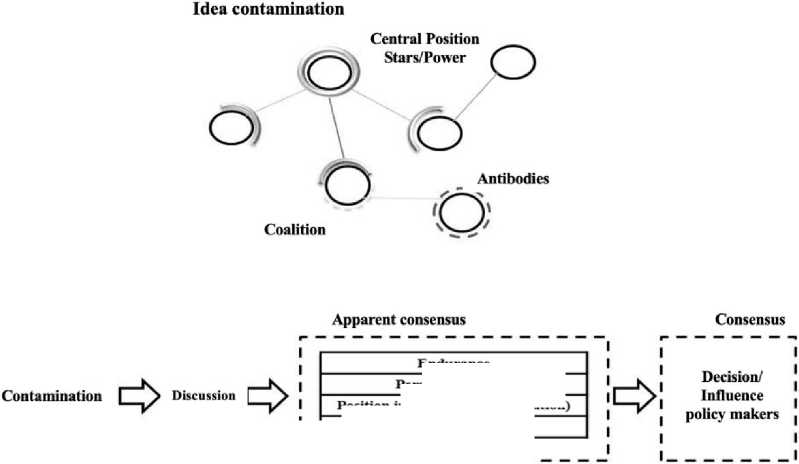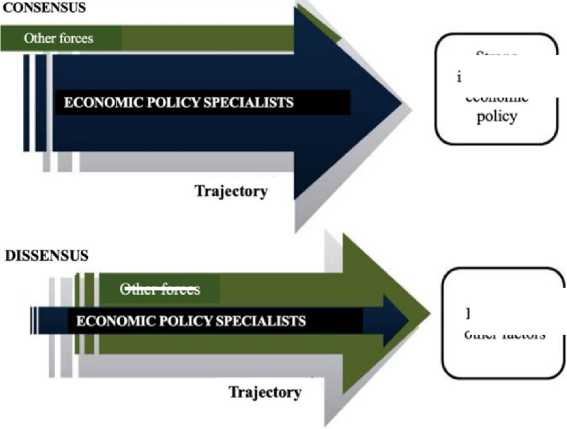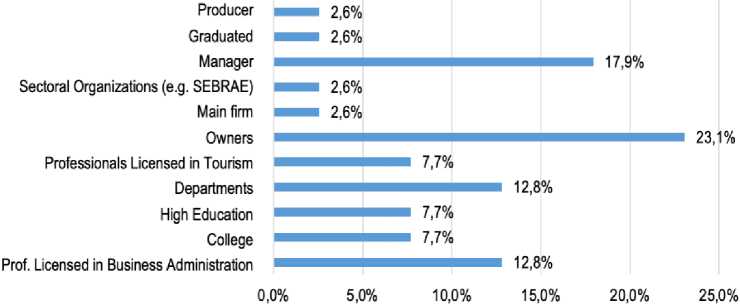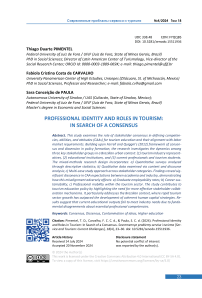Professional Identity and Roles in Tourism: In Search of a Consensus
Автор: Thiago Duarte Pimentel, Fabíola Cristina Costa de Carvalho, Sara Conceição de Paula
Журнал: Современные проблемы сервиса и туризма @spst
Рубрика: Локальное в глобальном: формула туризма
Статья в выпуске: 4 т.18, 2024 года.
Бесплатный доступ
This study examines the role of stakeholder consensus in defining competencies, abilities, and attitudes (CAAs) for tourism education and their alignment with labor market requirements. Building upon Farrell and Quiggin's (2012) framework of consensus and dissension in policy formation, the research investigates the dynamics among three key stakeholder groups in a Brazilian urban context: (1) tourism industry representatives, (2) educational institutions, and (3) current professionals and tourism students. The mixed-methods research design incorporates: a) Quantitative surveys analyzed through descriptive statistics; b) Qualitative data examined via content and discourse analysis; c) Multi-case study approach across stakeholder categories. Findings reveal significant dissonance in CAA expectations between academia and industry, demonstrating how this misalignment adversely affects: a) Graduate employability rates; b) Career sustainability; c) Professional mobility within the tourism sector. The study contributes to tourism education policy by highlighting the need for more effective stakeholder collaboration mechanisms. It particularly addresses the Brazilian context, where rapid tourism sector growth has outpaced the development of coherent human capital strategies. Results suggest that current educational outputs fail to meet industry needs due to fundamental disagreements about essential professional competencies.
Consensus, Dissensus, Contamination of ideas, Higher education
Короткий адрес: https://sciup.org/140309803
IDR: 140309803 | УДК: 338.48 | DOI: 10.5281/zenodo.15511936
Текст научной статьи Professional Identity and Roles in Tourism: In Search of a Consensus
Article History
Disclosure statement
Received 14 July 2024
No potential conflict of interest
Accepted 20 November 2024
was reported by the author(s).

This work is licensed under the Creative Commons Attribution 4.0 International (CC BY-SA 4.0).
To view a copy of this license, visit
ПИМЕНТЕЛЬ Тиаго Дуарте
Федеральный ун-т Жуис-ди-Фора / UFJF (Жуис-ди-Фора, шт. Минас-Жерайс, Бразилия) доктор социальных наук; директор Латиноамериканского центра туризма;
заместитель директора Центра социальных исследований;
КАРВАЛЬЮ Фабиола Кристина Коста
Университетский Панамериканский центр передовых исследований, Unicepes (Ситакуаро, шт. Мичоакан, Мексика);
ПАУЛА Сара Консейсан
Автономный Университет Синалоа / UAS (Кульякан, шт. Синалоа, Мексика);
Федеральный ун-т Жуис-ди-Фора / UFJF (Жуис-ди-Фора, шт. Минас-Жерайс, Бразилия) магистр экономических и социальных наук
ПРОФЕССИОНАЛЬНАЯ ИДЕНТИЧНОСТЬ И РОЛИ В ТУРИЗМЕ: В ПОИСКАХ КОНСЕНСУСА
Статья рассматривает соответствие формируемых навыков, способностей и отношений (НСО) в образовании в сфере туризма потребностям рынка труда. Автор определяет соответствие термином «консенсус». Обзор литературы основан на аргументе о консенсусе и расхождении взглядов, предложенном Фарреллом и Куиггином (2012). Исследование было проведено с участием трех групп акторов в городах Бразилии: рынка труда, образовательных учреждений, профессионалов и студентов туризма. Количественные и качественные данные анализировались с помощью дескриптивной статистики, контент-анализа и дискурса. Результаты и выводы свидетельствуют о недостаточном консенсусе относительно ожидаемых НСО на рынке труда в сфере туризма, что влияет на профессиональную интеграцию, сохранение и мобильность карьеры.

Дата поступления в редакцию: 14 июля 2024 г.
Дата утверждения в печать: 20 ноября 2024 г.
Introduction
This article aims to discuss how the consensus among the central actors of tourism influences the definition and congruence of what should be the competences, abilities and attitudes (CAAs) in tourism education process and its connection with the labour market. It is based on Farrell and Quiggin (2012) theory applied in politics studies, to elucidate the dynamics of building the definition and correspondence of what competences, skills and attitudes should compose the profile of a specialist in tourism.
The relevance of this study lays on the fact that it has not been explored in the context of tourism activity, particularly in Latin America, which takes the sector as a promoter of local development, but hardly considers the synchronous force of multiple actors in the social space, specifically, in the definition of CAAs of professionals trained in tourism and its capacity of job insertion and relevance in the sector.
Theoretical Review: The relevance of a consensus in a community of experts
This analysis is based on the theory of consensus and dissensus articulated by Farrell and Quiggin (2012) centred on authors such as Gourevitch (1986) and Hall (1989), which expresses the articulations between the interference of a community holding a given knowledge, i.e. experts, and their influence on the unfolding of a perspective in politics or society through the contamination of ideas, which can determine whether ideas or a particular conception are influential.
From their studies, we assume that the consensus among the central actors of tourism regarding the relevance of the definition and congruence of the CAAs profile, interferes in the planning of a destination and the professionalization of tourism local trade and services, which, in turn, would necessarily be involved with the professionalization of the sector. Farrell and Quiggin (2012) sketch a theory of networks and contamination of ideas to explain the relevance of a consensus of a group of experts on a specific social-political aspect. This dynamic can be distinguished in two moments (Fig. 1).
The first is the process of building consensus and / or dissensus in a community of experts. The second is how this community of experts influences policy and other members of society through its positioning. According to the authors, initially, the process starts from dissension, which would be a system in equilibrium where a set of ideas is not saturated. Ideas float, are existing, but are not discussed or cannot contaminate other members, resulting in little influence on policies. From a crisis or any element capable of breaking the balance of the system, there is a contamination of ideas that is configured as an apparent consensus. Here, the importance of the connection in social schemes and structures as well as the position in the network stands out.
According to the authors, the consensus formed may even influence the implementation of the policy. Here, it is worth noting that it does not matter the agreement with the idea itself. What is relevant for an idea to have contamination is its discussion, that is, to establish a common acceptance among different actors about its relevance. This process involves asymmetric power between dominant actors in a situation of fundamental disagreement.
For the authors, when an idea propagates and reaches space for discussion, it can become an alternative to the current thinking. Thus, the configuration of consensus and its structure, if established in the level of influence, and who propagates better, tends to remain and become an alternative. In addition, they affirm that in such dynamics one must consider the power issues in these ideas articulated in the communities (Fig. 2).

Nodes it belongs to ' Opinion
Endurance Personal interests Position in the network (Affiliation)

Other forces
Low freedom of decision-making for those who make economic policies
High freedom of decision-making for those who make economic policies
Strong influence on economic
Influence of other factors
Methodology
The article presents visions and expectations about competencies, abilities and attitudes of distinct – and complementary – points of view of actors in tourism filed. The results were supported by an empirical investigation in a city of the state of Minas Gerais, Brazil1. The main actors involved in this research about labour practices and professional competencies in the tourism sector were: (1) the firms ofthe touristic trade, given by entrepreneurs and government actors; (2) the higher education institutions (HEI); and (3) the professionals (graduates and students).
The purpose of this study was to elucidate the synchronic or diachronic strength of the multiple actors in the same social space in face with the central competences in tourism training and its socio-productive implications such as valorisation, employability and professional mobility (career advancement).
Methodologically, the research assumes a mixed (quantitative and qualitative) and flexible design. In the quantitative part, we have carried out a survey with the professionals and part of the firms existing in the touristic trade. The sample was composed by 198 semi-structured questionnaires (see Table 1).
Table 1 – Categories of analysis: main actors in the tourism sector of Juiz de Fora (MG, Brazil)
Source: made by the authors regarding the data of empirical research
Data relative to labour market and students were analysed by the descriptive statistics. On the other hand, the data relative to the Higher Education Institutions were collected using qualitative technique, particularly through the interviews with the representative actors of these HEIs. Also some interviews were conducted with the CEOs and main directors of the most representative firms in the local tourism trade. Due to the mixed nature of the research, a comparative multi-case study, we have organized the data following each case (group) and its specific technique employed to data collection and analysis in order to conduct the research.
Results and Discussion
The firms of the touristic trade, given by entrepreneurs and government actors
It was identified that 93% of the firms of tourism trade are micro and small firms – specifically 47.22% are micro firms and 45.83% are small firms, while 6.94% are medium size firms and 1.38% are big enterprises; 60.3% of these firms operate exist for more than 10 years, however, they have a low profile of professionalization and competitiveness. In consequence of these characteristics actors involved in production planning are mostly concentrated in charge of owners (23.1%), followed by managers (17.9%), specific departments (12.8%), administrators (12.8%). Subsequently, matrix, producer, post-graduate professionals, external bodies take part in 2.6% of the existing firms (Fig. 3).

Figure 3 – Actors involved in planning process in the firms
Source: Elaboration according to research data
It was identified that 51% of the firms never hired somebody with degree in tourism, particularly this is significant in the areas more indirectly related to tourism activities, such as small food establishments and transport companies or services in general. However, even more traditional branches of tourism, such as agencies and hotels, are included in this proportion. Specifically, according to their size, it was observed that micro-enterprises (57.2%) are the ones that most contract specialists in tourism, while 34.3% of the enterprise that hire this professional are small size enterprises.
The data highlights that smallest businesses, including in more traditional areas such as hotels, are unaware of the role and actions of a professional with degree in tourism. Instead, they say that they focus on personal factors - communicational skills, for example – or casuistic – need to fill a vacancy.
According to some interviewees, these professionals, that come from the colleges, is unaware of the reality of micro and small companies and their management challenges. They claim that the profile of the medium and large firms that are the focus of the high education courses, is different from the professional to small business. And it is exactly these organizations that give shape to the tourist destination and also corresponds to the most representative segment that can offer most of the jobs. However, this segment is surrounded by impasses that affect the very development and professionalization of the tourist destination.
Higher Education Institutions (HEI)
The discourse analyses of directives, professors and researchers of HEI’s in Juiz de Fora shows that there is a lack of definition and fragmentation in relation to the very conception of what is to be tourism, which is reflected in the positions of how these professionals tend to face the phenomenon and its relation with the praxis.
Firstly, the curriculum of the course does not have the definition of a specific interest, that is to say, the definition of tourism is not clear, opening up to several actions in the market. Another aspect is in relation to the labour market, which is very restricted and does not incorporate the recent graduates, as it believes that this professional does not have the necessary requirements. It was also possible to perceive that there is an individualistic view in the discourse that relates the responsibility for the failure of the professional to the student performance and action.
In addition, there are contradictions regarding the definition if the program is to form or not to the market job, and also regarding the role of the teacher associated with its incorporation into the application of theory and practice. In this way the student can get lost himself, with no knowledge of where to act. It was assumed that these aspects represent a reflection of the level of organization and development of tourism at the national level, as well as contributing to inform the challenging issues that refer to the theme.
Professionals (graduates and students)
Regarding the professionals of the organizations of the sample it was identified that although 71% of employees have relation with worker’s law, followed by trainees (6%), outsourced (5%), freelancers (5%), other (9%) and 4% without employees, predominantly the wage ranges are 1 to 2 minimum wages. This remuneration is mostly low and ranges from a minimum of up to two minimum wages (MW) and a maximum of up to four. The average compensation of the employees of the chain also concentrates in this same interval (Fig. 4).

-
■ RsnUeJ ■ КиМппи ^m Ui^-fl
Figure 4 – Recruitment profile
There are distinctions between the levels of competences desired by the labour market and those highlighted by students in training. The trade presents a considered reduction of the levels of importance of categories mainly related to management and planning. This aspect is confirmed when analysing the contracting of such organizations: 28% hire professionals for operational level, 34.7% hire students in the "internship" modality and 50.7% never hire a professional with vocation training in tourism.
The CAAs for firms focus on: sales (79.4%), understanding human behaviour (88.8%) (which is also a category related to sales), and, for a category related to resource management that represents a close link with management and planning, is not mentioned.
The results point that there is a misunderstanding on the part of the student regarding the formation on the field and its potential, as they consider language skills (89%), destination promotion (84.2%) and to elaborate projects (74.2%) as some of the important competences they must develop. Consequently, there is an inconsistency between the active role of the student in his course and his performance in the tourism market challenges.
Conclusion
As conclusion we argue that (1) that there is a major divergence between the groups about the competencies that tourism market looks for, (2) marking a clear absence of professional identity, which has implications for, (3) the insertion of professionals in the in labour market, its maintenance and provision of professional mobility.
The results indicate a close relationship between the difficulty accessing employment in the tourism labour market and a disagreement between the actors in relation to the CAAs. These evidences have direct implications both to the practice and also to theory in tourism education. First because it deals with the necessity of suit theoretical contents studied and their practical application in the work ground of the firms. The second one refers to the professional identity of this profession and its professional practices. Thus, the definition of a specific professional identity in tourism professional practice is strongly interconnected and its socio-productive implications such as valuation, employability and professional mobility (career advancement).
Farrell and Quiggin's (2012) theory of consensus and dissensus allowed to identify that there is a context of dissension in the case studied, which reflects an equilibrium system that supports differing perspectives when it comes to the required CAA of a tourism professional. The mismatch between the perspectives between the market, the education institution and the students themselves makes difficult the process of consolidation of the professional and employment identity, as a divergence is clearer in the areas of planning and management in the tourism in front of operational activities.


